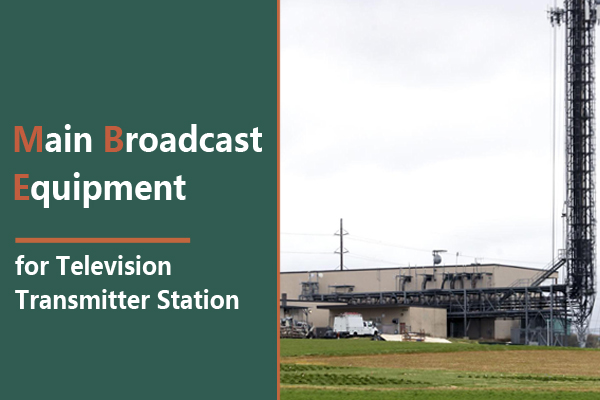
Hot tag
Popular search
Best Broadcast Equipment for a TV Transmitter Station

Over-the-air television is an essential TV broadcasting method that transmits TV signals to the viewers through the TV transmitter station. Have you ever learned about the broadcast equipment used in the TV transmitter station? This blog covers the basic information about the TV transmitter station, the introduction to the television broadcast equipment, finding the best television broadcast equipment, etc. If you work in TV broadcasting companies or are a hobbyist in TV broadcasting, this page is just for you.
Sharing is Caring!
Content
- 3 Facts to Know About TV Transmitter Station
- How to Improve My TV Signals?
- How Does a TV Transmitter Station Work?
- Main Transmitting Equipment Used in TV Transmitter Station
- How to Choose the Best TV Broadcast Equipment?
- Frequently Asked Questions
- Conclusion
3 Facts You Must Know about TV Transmitter Station
Let's have a simple understanding of the TV transmitter station first before we learn about the transmitting equipment used in the TV transmitter station.
The Aim is to Transmit TV Signals
As the name suggests, the TV transmitter station is mainly used for transmitting the audio signals and video signals outward. It contains the TV broadcasting equipment working for transmitting TV signals, including the TV broadcast transmitter, TV transmitting antenna, the Studio Transmitter Link receiver equipped with an antenna, etc.
The Location Should be Setting as High as Possible
Typically, the TV transmitter station would be built on the top of the mountain, usually miles away from the TV station. Because every TV broadcaster wants to make, TV signals cover a more extensive range at less cost and the way of installing the TV transmitting antennas as high as possible costs less.
How to Improve My TV Signals?
1. Installing Your TV Transmitting Antennas Higher
The audio signals and video signals are radio waves. If some high buildings block them, the TV signals would be weakened and can't reach the place far away. So installing the TV transmitting antennas higher is an excellent way to avoid the obstacles.
2. Choosing the Best TV Broadcast Antennas
The best TV broadcast antenna should be high-gain and withstand high transmitting power. A high-gain antenna can concentrate the energy used to transmit radio waves, and the TV signals can reach farther.
3. Selecting a High Power TV Broadcast Transmitter
Replacing a high-power TV broadcast transmitter is also a way for enlarging the coverage because TV signals with more power have a better capability of going through the buildings.
How Does a TV Transmitter Station Work?
Before the TV transmitter station broadcasts the TV signals outward, it should first receive the signals from TV stations. So the broadcast equipment works together in 3 steps as follows:
Step 1
The UHF TV transmitter Receives the audio signals and video signals from TV stations through Studio Transmitter Link receiving antenna.
Step 2
The signals are moved to the TV transmitter, processed, and converted into current signals.
Step 3
The current signals are transferred to the TV antenna attached to the Radio Tower and generate radio signals to broadcast.
Now you have a clear concept of the operation of the TV transmitter station. Next, let's learn about what television broadcast equipment is used in the TV transmitter station.
Common Transmitting Equipment Used in a TV Transmitter Station
There are at least 3 kinds of equipment in a TV transmitter Station, including a TV broadcast transmitter, TV transmitting antenna, and studio transmitter link equipment, etc.
1. Television Broadcasting Transmitter
- Definition - A TV broadcasting transmitter is a kind of transmitting equipment for broadcasting audio signals and video signals. It takes the role of receiving the audio signals and video signals from Studio Transmitter Link transmitter, processing signals, and converting them into current signals. Finally, the signals will be transferred to the TV transmitting antenna.
- Types - Usually the TV broadcasting transmitter can be divided into the analog television transmitter and digital television transmitter in modulation method. Now more and more countries are eliminating analog TV transmitters and promoting digital ones because the digital television transmitters can not only broadcast more channels but also broadcast high definite video and high-quality audio signals.
Also Read: Analog & Digital TV Transmitter | Definition&Difference
- Frequency - The available radio frequency ranges for the TV broadcasting transmitter are VHF and UHF. And each TV channel takes over the bandwidth of 6 MHz. The following are the frequency band in detail:
|
54 to 88 MHz for channels 2 to 6 174 to 216 MHz channels 7 to 13 470 to 890 MHz for UHF channels 14 to 83 |
A wider range of frequencies comes with more transmitting channels. It means that you can broadcast more programs and earn a more extensive range of viewers.
2. Television Transmitting Antenna
A TV transmitting antenna is essential for transmitting TV signals. The electric current on the TV antenna will create radio waves and the antenna would transmit them. In addition, the TV broadcast antenna can help improve the TV signals and adjust radio waves' intensity and direction as you want.
Typically, there are mainly two types of TV transmitting antennas used in TV broadcasting: VHF & UHF TV panel antenna and UHF TV slot antenna.
- VHF or UHF TV Panel Antenna
The panel TV antenna is used in the frequency range of VHF and UHF. Because it can only transmit signals at an angle of 90 °, it is a directional antenna.
-
UHF TV Slot Antenna
The slot antenna is a kind of UHF TV antenna. Different from panel antenna, it is a type of omnidirectional antenna, which means that a single slot antenna can send radio signals in all directions.
Here are the advantages of the UHF TV panel antenna versus the UHF TV slot antenna
| UHF TV Panel Antenna | UHF TV Slot Antenna |
|
|
3. Studio Transmitter Link
As we mentioned before, a TV transmitter station needs Studio Transmitter Link to receive the TV signals from the TV broadcast station.
Studio Transmitter Link is a kind of point-to-point broadcast system, and it can be used in long-distance transmission. It allows the TV transmitter site to be built in the best place for TV signals transmission as possible as it can.
Also Read: How Does A Studio Transmitter Link Work?
How to Choose the Best TV Broadcast Equipment?
TV broadcasting is such an essential public service that it highly requires TV broadcast equipment. So for people who want to build up a new TV station, it is important to know how to choose the best TV broadcast equipment.
Quality Assurance
The quality of TV broadcast equipment should be ensured. A high-quality TV broadcast equipment comes with reliable and long-range transmission capability and the lowest rate of failure. In addition, a TV broadcast transmitter with a larger bandwidth can help you earn more viewers with more channels and bring TV broadcast companies more benefits.
User Friendliness
A good product should consider user operation preference, so user-friendliness is essential. So does a TV broadcast transmitter and TV broadcast antenna. It should be designed to suit the user's preference.
For example, a TV broadcast transmitter should be equipped with a clear screen for operation and allow the operators to finish setting in a short time. And a TV transmitting antenna should be easily installed, and it can reduce the difficulty for installing and maintenance.
Safety and Protection
Safety and protection programs are important for any TV broadcast equipment. Such as TV broadcast transmitters, it is impossible to monitor its status at any time. If it can stop working before breaking down, it can timely avoid damage to the machine and the other equipment around.
Reliable Brands
No one can predict what would happen to the machine, so reliable brands are important. They can provide you with the perfect after-sales. It means that you can get timely help to fix various technical problems of the machine, and reduce the loss to the minimum.
FMUSER is one of the best TV broadcasting equipment suppliers worldwide. We provide complete TV broadcast equipment packages, including VHF & UHF TV transmitter, TV broadcast antennas with antenna cables, connectors, and other necessary accessories. If you need to buy any TV broadcast equipment, please feel free to contact us!
Also Read: How to Choose the Best Analog TV Transmitter for Your TV Transmitter Station?
A: Following is the list of the frequency range available. TV transmitter works in parts of VHF and UHF in the frequency range. Specifically, there are three frequency ranges are available for TV transmitters.
- 54 to 88 MHz for channels 2 to 6
- 174 to 216 MHz channels 7 to 13
- 470 to 890 MHz for UHF channels 14 to 83
2. Q: How TV signals are broadcast to the viewers?
A: TV signals will be broadcast to the viewers in three steps:
1) The Studio Transmitter Link receiving antenna Receives the audio signals and video signals from TV stations.
2) The signals are moved to the TV transmitter, processed, and converted into current signals.
3) The current signals are transferred to the TV antenna and generate radio signals to broadcast.
3. Q: Which is better, a digital TV transmitter or analog TV transmitter?
A: If you are considering image definition, sound quality, and channel amount, a digital TV transmitter will be your best choice. But if you are considering prices, the signals coverage, an analog TV transmitter will be the best choice for you.
4. Q: Why do we use the UHF TV transmitter and UHF TV antenna?
A: Compared with VHF television broadcasting, UHF television broadcasting has the following advantages:
- As its frequency is higher, the wavelength is shorter so that UHF signals can pass through smaller openings compared to VHF signals.
- Due to its short wavelength, the receiving antenna used in UHF can be much smaller than those used in VHF.
- UHF signals are less susceptible to diffraction.
- UHF has a wider bandwidth so it can broadcast more TV channels.
In this blog, we know the basic information about TV transmitting sites, the equipment used in the transmitting site, and how to choose the best TV broadcast equipment. If you are not ready to build a TV transmitter station yet, why not choose FMUSER? We have complete TV turnkey solutions and TV broadcast equipment. Best quality, best prices. Contact us right now! We hope this blog is helpful to build your understanding of the TV transmitting equipment.
Tags
Contents
Related Articles
CONTACT US


FMUSER INTERNATIONAL GROUP LIMITED.
We are always providing our customers with reliable products and considerate services.
If you would like to keep touch with us directly, please go to contact us




